OSPF Questions 5
Here you will find answers to OSPF Questions – Part 5
Question 1
A network administrator has enabled OSPF across an NBMA network and has issued the command ip ospf network nonbroadcast. Given those facts, which two statements are true? (Choose two)
A. DR and BDR elections will occur.
B. DR and BDR elections will not occur.
C. All routers must be configured in a fully meshed topology with all other routers.
D. The neighbor command is required to build adjacencies.
E. Interfaces will automatically detect and build adjacencies with neighbor routers.
Answer: A D
Explanation
When using the command “ip ospf network nonbroadcast”, we turn the network into a nonbroadcast network so routers can not send broadcast or multicast. But OSPF uses multicast address 224.0.0.5 to send Hello packet periodically. Therefore we have to manually define the neighbor (via the neighbor command) to make OSPF send Hello packets to its adjacent routers -> D is correct.
For Multi-access network (for example Ethernet or Frame Relay), a designated router (DR) and a backup designated router (BDR) are elected ->A is correct.
Note: By default, Frame Relay environment is nonbroadcast so it is actually not necessary to use the command “ip ospf network nonbroadcast” on Frame Relay network.
Question 2
RouterA#
~~~~~
!
router ospf 1
log-adjacency-changes
network 10.0.0.0 0.255.255.255 area 1
network 172.16.1.0 0.0.0.255 area 1
!
~~~~~
RouterB#
~~~~~
router ospf 1
log-adjacency-changes
network 10.0.0.0 0.255.255.255 area 2
network 172.16.2.0 0.0.0.255 area 2
!
~~~~~
RouterC#
~~~~~
!
router ospf 1
log-adjacency-changes
network 10.0.0.0 0.255.255.255 area 0
!
~~~~~
Refer to the exhibits. You are verifying your OSPF implementation, and it does not seem to be functioning properly. What can you conclude from the exhibit and the show running-configuration command output?
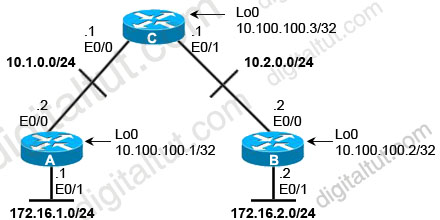
What can you conclude from the exhibit and the show running-configuration command output?
A. The OSPF areas are not configured correctly.
B. The wildcard masks for the 10.x.x.x networks are incorrect.
C. The 172.16.x.x networks need to be connected to area 0 using virtual links.
D. The 172.16.x.x networks are discontiguous. OSPF is automatically summarizing them to 172.16.0.0/16 and data is being “black holed”.
E. There is not enough information to make a determination.
Answer: A
Explanation
The E0/0 & E0/1 interfaces of router C belong to area 0 while E0/0 of router A belongs to area 1; E0/0 of router B belongs to area 2 -> it is not correct. Both E0/0 interfaces of router A & B should be in area 0 -> A is correct.
Question 3
Which two routing interface parameters are supported in OSPF implementations? (Choose two)
A. retransmit-interval
B. dead-interval
C. stub area
D. virtual link
E. NSSA area
Answer: A B
Explanation
When OSPF sends an advertisement to an adjacent router, it expects to receive an acknowledgment from that neighbor. If no acknowledgment is received, the router will retransmit the advertisement to its neighbor. The retransmit-interval timer controls the number of seconds between retransmissions. To edit the retransmit-interval, use the “ip ospf retransmit-interval seconds” in interface configuration mode -> A is correct.
Dead-interval is the number of seconds without hello packets before an adjacency is declared down. To edit the dead-interval, use the “ip ospf dead-interval seconds” in interface configuration mode -> B is correct.
Other answers are not correct because they are not interface parameters.
Question 4
One of the most important characteristics of OSPF is Multiple areas. Which statement best describes why this feature is such an important enhancement to earlier routing protocols?
A. The network domain, when divided into areas, allows for the use of both IANA classful addressing and private addressing.
B. The use of multiple areas allows for the use of prioritization.
C. All computation is kept within the area, with minimum communication between the areas, allowing the network to scale to larger sizes.
D. It is easier to implement security.
Answer: C
Question 5
When other routing protocol routes are being redistributed into OSPF, what is one of the most common problems?
A. missing the tag option in the redistribute command.
B. missing the subnet option in the redistribute command.
C. missing the metric option in the redistribute command.
D. misconfiguring the metric-type option in the redistribute command to type-1.
E. misconfiguring the metric-type option in the redistribute command to type-2.
Answer: B
Explanation
When pulling routes into OSPF, we need to use the keyword “subnets” so that subnets will be redistributed too. For example, if we redistribute these EIGRP routes into OSPF:
+ 10.0.0.0/8
+ 10.10.0.0/16
+ 10.10.1.0/24
without the keyword “subnets”
router ospf 1
redistribute eigrp 1
Then only 10.0.0.0/8 network will be redistributed because other routes are not classful routes, they are subnets. To redistribute subnets we must use the keyword “subnets”
router ospf 1
redistribute eigrp 1 subnets
-> B is correct.
Question 6
Refer to the exhibit. Which statement is true about the configuration?
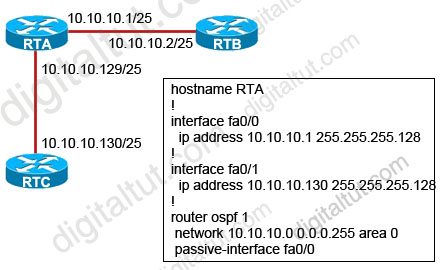
A. RTA will not establish an OSPF adjacency with RTB.
B. RTA will not accept OSPF hello packets from RTB.
C. RTA will send OSPF hello packets, but will not send OSPF updates.
D. RTA will send OSPF updates, but will not establish an adjacency with RTB.
Answer: A
Explanation
Passive-interface command is used to disable sending updates out from a specific interface. For OSPF it prevents Hello packets from being sent out or received through the interface. This will not allow to create a neighbor adjacency and prevent a router from learning prefixes from those neighbors.
For RIP, configuring an interface as passive will still allow the interface to listen to incoming routing updates for other RIP neighbors, but the interface will no longer send them.
Note: The passive-interface command is used in router configuration mode, not interface mode.
Question 7
Refer to the exhibit. Which statement is true?
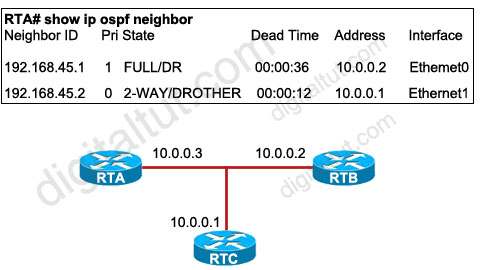
A. Router RTA is directly connected to interface 192.168.45.1.
B. Neighbor 192.168.45.1 has changed its OSPF priority number.
C. Router RTA and neighbor 192.168.45.2 are exchanging OSPF LSAs.
D. Router RTA is the BDR.
Answer: None (but we recommend the best choice is D)
Explanation
There are only 3 routers in this segment. From the output we learn that RTB (10.0.0.2) is the DR and RTC (10.0.0.1) is not the DR or BDR so we can deduce RTA is the BDR.
But there is a problem with the output on RTA. If RTA is the BDR, the connecting state to RTC should be FULL/DROTHER, not 2-WAY/DROTHER. So we suppose the exhibit in this question is not correct.
A is not correct because 192.168.45.1 may not be an interface. It can be a router-id which can be set by the “router-id …” command.
B is not correct because as we can see in the output above, the OSPF priority number of RTB is 1 and it is the default value.
If the output above is correct then RTA and RTC are not DR or BDR -> they don’t exchange OSPF LSAs -> C is not correct.
(Good link for reference: http://www.cisco.com/en/US/tech/tk365/technologies_tech_note09186a0080094059.shtml)
So what will happen if we set the OSPF priority number of RTA to 0? Well, you will get the same output as above but the problem here is none of the above answers is correct.
In conclusion, answer D is only correct when the connecting state from RTA to RTC is FULL/DROTHER.
Question 8
Refer to the exhibit. All routers have simultaneously been reloaded, and the DR election has concluded as expected. Which state is RTC in?
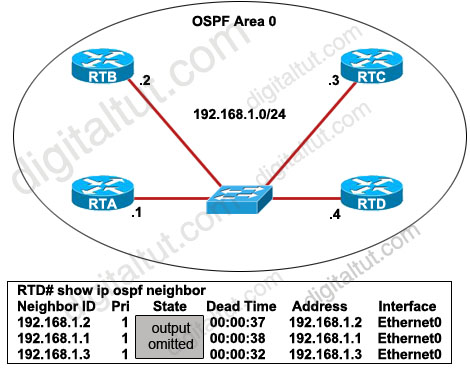
A. 2WAY/DROTHER
B. 2WAY/BDR
C. 2WAY/DR
D. FULL/DROTHER
E. FULL/BDR
F. FULL/DR
Answer: E
Explanation
All the routers are allowed to take part in the DR/BDR election because all the “Pri”s (Priority) are 1 and they are equal so with default parameters, the router with highest IP address will become DR (RTD in this case) and the router with second highest IP address (RTC) will become BDR.
Question 9
The Dev-1 and Dev-3 routers are OSPF neighbors over the Ethernet 0/0 connection. Based on the show ip ospf neighbor output from the Dev-1 and Dev-3 routers, which statement is true?
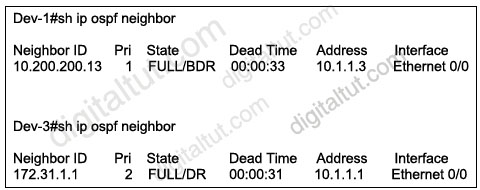
A. Dev-1 is the DR because it has a higher OSPF router priority.
B. Dev-1 is the DR because it has a lower OSPF router ID.
C. Dev-3 is the DR because it has a higher OSPF router priority.
D. Dev-3 is the DR because it has a lower OSPF router ID.
E. Both Dev-1 and Dev-3 are using the default OSPF router priority.
Answer: A
Explanation
The priority helps determine the DR and BDR on the network to which this interface is connected. Priority is an 8-bit field based on which DRs and BDRs are elected. The router with the highest priority becomes the DR. If the priorities are the same, the router with the highest router ID becomes the DR. By default, priorities are set to 1.
Notice that the Priorities shown in the output above are the priorities of the neighbors so the priority of router Dev-1 is 2 while the priority of Dev-3 is 1 -> the priority of Dev-1 is higher than that of Dev-3 -> Dev-1 is the DR.
Question 10
Which three statements about OSPF areas are true? (Choose three)
A. Areas introduce a boundary on the link-state updates.
B. Areas are logical definitions specific to any given router.
C. All routers within an area have the exact link-state database.
D. The calculation of the Dijkstra algorithm on a router is limited to changes within an area.
E. The area designated router will always have a priority of 0.
Answer: A C D



If some one desires expert view about blogging and site-building after that i suggest him/her
to visit this website, Keep up the good job.cheap nfl jerseys
How to get jerseys from china? Tips you may used. jerseys from china
passed today with 842
all the questions were from the 149+41+waleed 15 nothing else
these dumps are still vaild
@Edie Nhema::
– you answered yourself, mate in yours cisco citation.
When you configure the neighbors, it starts the election process then.
So A,D is correct for Q1